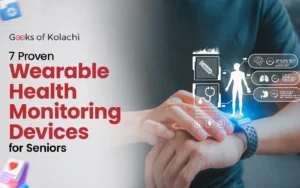
How to Use Clinical Analytics to Improve Patient Care and Outcomes
Healthcare is undergoing a profound transformation powered by digital innovation, and at the heart of this shift is clinical analytics. From improving diagnosis to streamlining treatments and optimizing clinical trials, healthcare professionals are leveraging data like never before. But capturing data isn’t enough; it’s the ability to extract meaningful, actionable insights that truly makes a difference in patient outcomes.
Today, as hospitals across the U.S. integrate electronic health records (EHRs), artificial intelligence, and advanced analytics, the ability to make informed decisions at the bedside is rapidly evolving. In this blog, we explore how healthcare institutions can harness the full power of clinical data analytics to improve the quality of care, reduce costs, and enhance patient experiences.
What is Clinical Analytics and Why It Matters?
So, what is clinical analytic? Simply put, it involves the examination of healthcare data to uncover trends, predict outcomes, and drive clinical decisions. It blends data science, informatics, and medical knowledge to deliver insights that influence treatment plans and care delivery.
Healthcare providers now generate vast volumes of data through EHRs, lab tests, imaging, and even wearable devices. However, without meaningful interpretation, these data remain underutilized. Clinical decision support systems that improve safety help transform raw data into structured insights that lead to improved clinical performance.
Hospitals with strong clinical research analytics infrastructures can:
- Track patient outcomes more accurately
- Identify high-risk patients in real time
- Reduce hospital readmissions
- Personalize treatments based on patient history and behavior
The Pillars of Clinical Analytics in Patient Care
Patient care improvement depends on several analytics domains. Clinical healthcare analytics supports medical studies by interpreting trends and identifying actionable results. Healthcare clinical analytics assists in monitoring patient safety, clinical efficiency, and operational performance. It enables early detection of complications and supports evidence-based treatment protocols. Medical data analytics integrates biological, behavioral, and environmental data to create a holistic patient profile.
These areas intersect to create a unified ecosystem where data supports the care continuum—from preventive medicine to post-discharge follow-ups.
Clinical Trial Data: From Information to Insight Level
With the rise of precision medicine, clinical trials have become more data-intensive. Here’s where clinical trial data analytics play a crucial role. It allows researchers to monitor patient recruitment, track protocol deviations, and ensure data integrity across sites.
Data analytics clinical trials processes help pharmaceutical companies and researchers generate results that are reliable and faster. Using AI, clinical trial analytics software now enables near real-time monitoring and predictive insights. These platforms serve as vital solutions for medical optimization, enhancing trial accuracy and timelines.
For those interested in how real-world evidence shapes clinical research, these advancements provide a critical foundation for improved trial outcomes.
| Curious about how clinical analytics can transform your healthcare practice? We’d love to hear about your challenges and goals. Reach out anytime to chat about tailored solutions that make a real difference in patient care and operations. |
Tools and Technologies Leading the Way
A number of platforms are transforming how healthcare data is used. Technologies like IQVIA’s CDAS and elluminate’s clinical analytics software are revolutionizing data review and decision-making. Clinical analytics enables clinicians to interact with systems using voice and contextual triggers. Automation accelerates data ingestion, discrepancy detection, and dashboard generation. Self-service data exploration helps stakeholders track trial progress and ensure compliance.
With these innovations, clinical data analysis teams can act on data with unprecedented speed and precision. Many healthcare organizations are also investing in healthcare software solutions to integrate analytics smoothly into their existing workflows.
Real-World Applications: Improving Outcomes Now
Clinical quality analytics is no longer theoretical. Here are just a few use cases that have reshaped modern healthcare:
- Risk Stratification involves identifying patients who are more likely to experience complications, allowing clinicians to intervene proactively. This approach improves both the quality of care and resource efficiency by preventing adverse events before they occur.
- Predictive Analytics enables hospitals to foresee patient deterioration or emergency events even before they manifest physically. This leads to quicker decision-making and timely interventions, ultimately improving survival rates and recovery times.
- Resource Allocation becomes more precise with analytics, allowing hospitals to efficiently assign ICU beds, staff, and medical equipment based on real-time demand and risk levels. This ensures optimal use of limited healthcare resources.
- Reduced Readmissions is achieved by closely monitoring discharged patients, especially those with chronic illnesses. With data tracking and alerts, healthcare providers can ensure follow-up care and medication adherence, minimizing unnecessary returns.
A recent study highlights the importance of public health analytics in driving preventative care strategies, emphasizing how data can directly impact population health.
Recent healthcare improvements draw on insights from clinical data to enhance population health outcomes, demonstrating how analytics can transform preventive care strategies.
With tools such as clinical data software, these improvements are measurable and scalable. For healthcare providers looking for customized software development for healthcare, tailored platforms can better meet unique organizational needs and improve integration.
Organizational Challenges in Adopting Analytics
Despite widespread EHR adoption, most U.S. hospitals are not leveraging them to their full potential. A significant barrier is the lack of skilled clinical data analyst teams capable of interpreting and acting on insights. Siloed data and the absence of interoperability further hinder seamless data integration and analysis across departments.
Leadership involvement in health care data analytics strategy remains limited in many institutions, and without clear vision from the top, analytics programs often stagnate. Surveys show that only 44% of hospitals have a formal process for prioritizing quality improvement initiatives, and only 62% have a permanent analytics team. To overcome these issues, organizations need a culture shift that embraces data-driven decision-making at all levels.
The Future: AI, ML, and Predictive Modeling
The future of clinical development analytics is powered by intelligent automation. AI and machine learning algorithms can pre-plan subpopulation analysis, allowing for more personalized and effective trials. These tools also identify trial bottlenecks and inefficiencies, enabling proactive adjustments.
Next-generation platforms incorporate intelligent systems to automatically generate trial documents, monitor quality metrics, and ensure compliance with evolving regulations. This ensures that clinical insights are not just reactive reports, but strategic inputs that guide ongoing improvements in treatment and trial strategies.
Selecting the Right Clinical Data Solutions
Choosing the right clinical data solutions is critical to success. Ideal platforms should integrate seamlessly with existing hospital systems while offering intuitive interfaces for non-technical users. They must also include pre-built and customizable visualizations to support a wide range of clinical needs.
Equally important is the ability to empower clinicians and administrators with real-time decision support, enabling them to act quickly on emerging trends. Solutions like IQVIA’s CDAS and elluminate’s clinical trial data analytics suite combine powerful AI with user-friendly designs to help teams derive value from every patient interaction.
If you’re interested in improving patient engagement and outcomes further, you might also want to explore the top fitness app features to boost user engagement in 2025 — understanding patient behavior through digital tools can complement clinical analytics efforts.
Conclusion
The road to patient-centered care is paved with smart data. By implementing robust clinical analytics frameworks, healthcare organizations can transform vast datasets into real clinical impact. From improving hospital workflows to predicting adverse events, the benefits of analytics go beyond charts and dashboards—they save lives.
As more institutions embrace this digital transformation, collaboration between clinicians, data scientists, and IT teams will be vital. Together, they can move from “data-rich” to “insight-rich” and finally, to “action-ready.”
| Ready to take the next step in improving patient outcomes with data-driven insights? Our team is here to help you navigate clinical analytics solutions that fit your unique needs. Don’t hesitate—get in touch with us today to start the conversation. |
Frequently Asked Questions
1. What is clinical analytics?
Clinical analytics is the process of analyzing healthcare data from sources like electronic health records, lab results, and imaging to uncover patterns and insights that improve patient care, support clinical decisions, and enhance healthcare operations.
2. How does clinical analytics improve patient outcomes?
By identifying trends and predicting health risks early, clinical analytics enables healthcare providers to intervene proactively, reduce hospital readmissions, personalize treatments, and improve overall patient safety and recovery.
3. What types of data are used in clinical analytics?
Clinical analytics uses diverse data including electronic health records (EHRs), laboratory tests, medical imaging, patient demographics, and even data from wearable health devices to provide a comprehensive view of patient health.
4. What are common challenges in implementing clinical analytics?
Challenges include integrating data from different systems, ensuring data quality and interoperability, addressing privacy concerns, and the shortage of skilled analysts to interpret complex clinical data effectively.
5. How is clinical analytics different from traditional healthcare reporting?
Unlike traditional reporting that looks backward, clinical analytics provides real-time or near-real-time insights, enabling healthcare providers to make proactive, data-driven decisions to improve patient care and operational efficiency.
6. What are the key components of healthcare analytics?
Healthcare analytics involves data collection, data management, advanced data analysis using AI and machine learning, and visualization tools that help clinicians and administrators interpret data for better decision-making.
7. How do predictive analytics contribute to patient care?
Predictive analytics uses historical and real-time data to forecast patient deterioration, potential complications, or emergency events, allowing timely interventions that improve survival rates and reduce adverse outcomes.
8. What tools and technologies are used in clinical analytics?
Popular tools include platforms like IQVIA’s CDAS and Elluminate’s clinical analytics software, which leverage AI, automation, and self-service dashboards to streamline data analysis, monitor clinical trials, and support real-time decision-making.
9. What are real-world applications of clinical analytics in healthcare?
Clinical analytics helps in risk stratification to identify high-risk patients, optimizes resource allocation like ICU beds and staff, reduces hospital readmissions by tracking discharged patients, and enhances clinical trial accuracy and speed.
10. How does clinical analytics enhance patient safety?
By enabling early detection of complications, monitoring adherence to treatment protocols, and identifying patterns linked to adverse events, clinical analytics helps improve patient safety and prevent medical errors.
11. What is the role of artificial intelligence in clinical analytics?
AI enhances clinical analytics by automating data processing, generating predictive models, detecting anomalies, and supporting personalized medicine approaches, making healthcare more efficient and precise.
12. How can clinical analytics reduce healthcare costs?
By improving operational efficiency, preventing avoidable complications, reducing hospital readmissions, and optimizing resource use, clinical analytics lowers overall healthcare costs while improving care quality.
13. What are the benefits of integrating clinical analytics with electronic health records (EHRs)?
Integration with EHRs allows seamless access to real-time patient data, improves care coordination, supports personalized treatment plans, and enables faster clinical decision-making at the bedside.
14. How do healthcare providers use clinical analytics to improve operational efficiency?
Providers use analytics to streamline workflows, monitor clinical trial progress, allocate resources based on demand, and reduce bottlenecks, leading to smoother hospital operations and better patient experiences.



















